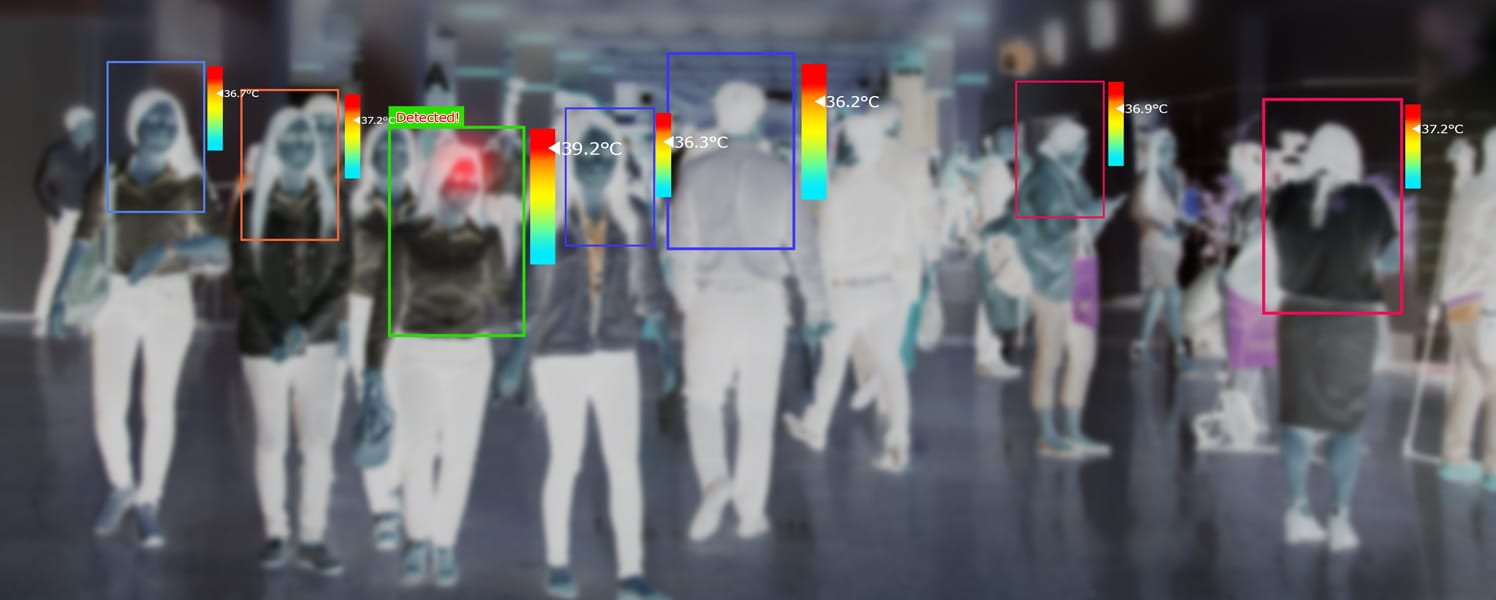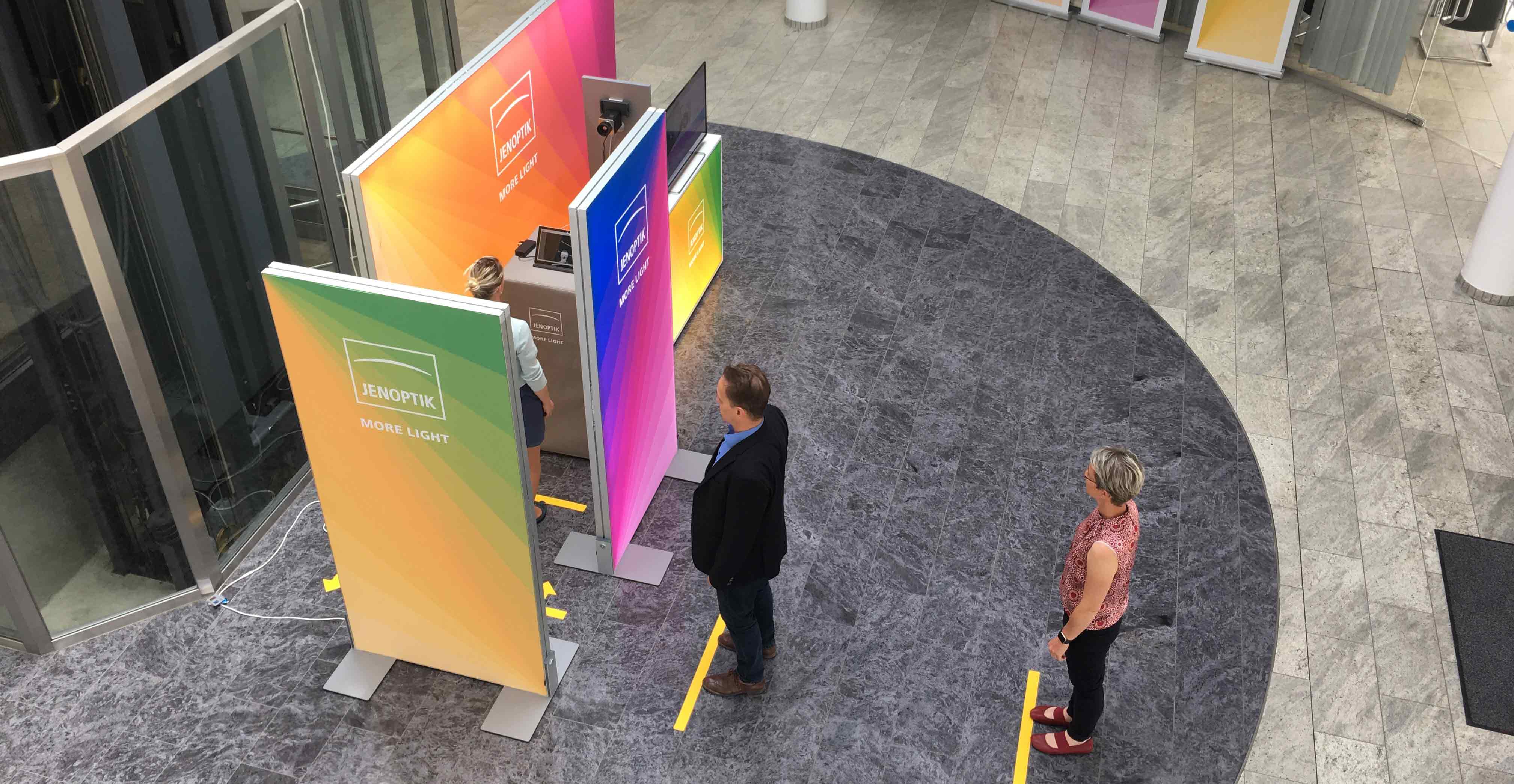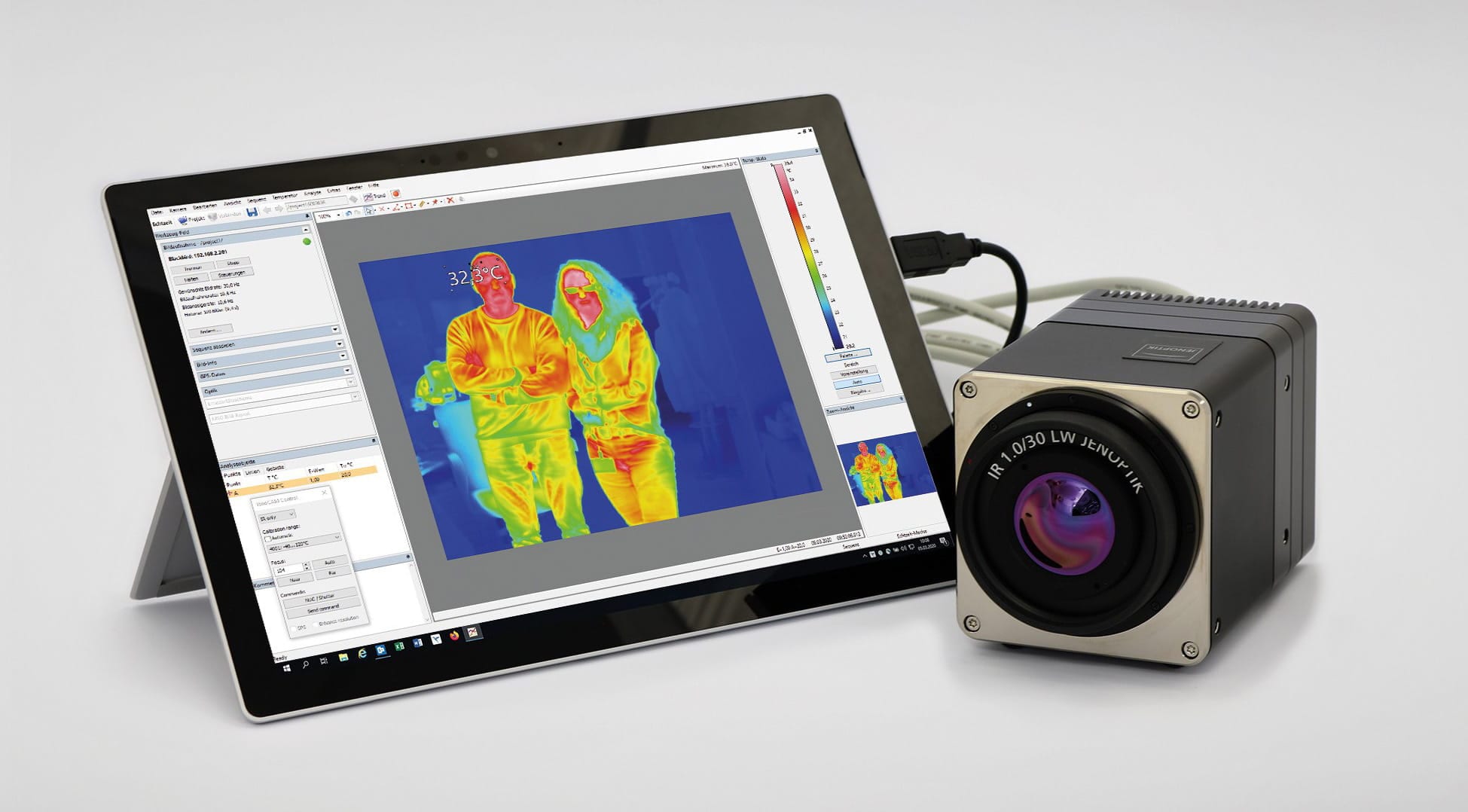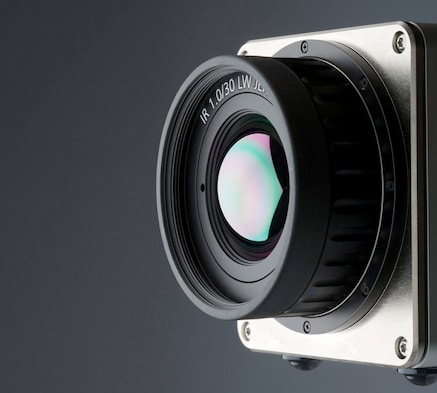RecommendMail Facebook LinkedIn
- Health & Science
- Digitization
Mobile measuring station for fever screening and fever detection using a thermal imaging camera
Since the outbreak of the coronavirus, many people wonder whether they should have measured their fever before leaving the house or entering places with many passers-by. But there’s often not enough time as the next train is about to leave or an important appointment is going to start soon. Wouldn’t it be useful to offer aids, such as thermal imaging cameras, for time-saving fever detection at certain central hubs?
, Daniel BrennerA quick trip to the supermarket at the end of the day, but you can already see the long queues at the cash registers. And there are also crowds of people on the train platform, especially at peak times in the early morning and late afternoon. And also in the foyers of hospitals and event locations, in front of elevators, and in buses and trains, people often get closer to one another than many would like. Meetings and crowds of people have been frowned upon since the beginning of the corona pandemic, but they are considered to be even more dangerous if there are no infection prevention measures in place.
Since the easing of lockdown and contact restrictions, people are once again out and about, filling up the streets and shops. Many people are wearing mouth and nose masks, as it is impossible to rule anyone out from being infected due to the particular nature of the infection. Do you feel ill? Feverish? No, not really. But on their way to work or while out shopping, some people may think it would have been better to have measured their temperature before meeting others at the office or the supermarket. Because there is always the risk of unintentionally spreading an infection. Wouldn’t it be practical to be able to provide aids for time-saving fever detection at certain central hubs or entrance areas? A smart doorman, so to speak, who decides whether to allow or prevent people from entering based on the currently measured body temperature to prevent the spread of infection.
Detect hidden infections and reduce the risk of spreading. With mobile measuring stations for fever screening using a thermal imaging camera.
Measurements like this should be fast, uncomplicated and preferably contactless – more or less when passing by. To ensure the greatest possible acceptance, fever screening must respect the personal rights of the people being measured, and thus should not register or store any personal attributes.
Flexible measuring stations with radiometrically calibrated infrared cameras, which are also called thermographic or thermal imaging cameras, offer a practical solution for mobile fever detection and fever screening. These make surface temperatures visible as thermal images, measure them and thus provide information about increased body temperature, i.e. a fever.
How does temperature measurement with a thermal imaging camera work?
An infrared camera works in a similar way to a video camera, except that it is not sensitive to visible light, but to long-wave infrared radiation. Infrared radiation is part of the electromagnetic spectrum, which we perceive as heat. Every body surface emits infrared radiation, which a thermal imaging camera makes visible in the form of a grayscale or false-colour image.
Thermographic cameras are specially calibrated infrared cameras that not only make heat radiation visible, but can also measure it. The result is a thermal image that displays the surface temperatures of the recorded objects or people. Each greyscale or colour in the image is now assigned a specific temperature. Thermographic cameras are often referred to as thermal imaging cameras.
A thermal imaging camera for fever detection and fever screening uses image analysis software to detect and mark the areas of an image where a defined temperature threshold has been exceeded. If the software detects that this temperature threshold has been exceeded in a person’s thermal image, this indicates the probability that this person has an elevated body temperature, i.e. a fever – which is generally an indication of an existing infection.
A mobile measuring station for fever screening comprises a thermographic camera to record the thermal images, image analysis software for flagging unusually high temperatures as an indication of fever, and a monitor for displaying the images. The measuring station can be installed at hubs with a high volume of people, for example in the foyers of office buildings, in factories, shopping centres, railway stations or airports, both for autonomous use and for supervised operation.
Mirror, mirror on the wall – the thermal imaging camera reflects temperatures in real time
In autonomous operation, the mobile measuring station can be used for continuous fever screening, as a kind of voluntary self-test for employees, visitors or travellers. When passing by the measuring station, the thermographic camera displays the thermal image of the person being measured directly on a monitor, just like glancing into a special mirror.
Temperatures that are evaluated as critical are automatically marked in colour in the thermal image, making it possible to see at a glance who might have a fever and needs to have this clarified by a doctor. The thermal image is transferred directly from the camera to the monitor via livestream and is not stored. No personal data is recorded. If the thermal image displays a critical temperature, thus indicating a fever, it is the responsibility of the person passing by to clarify this.

Thermal imaging cameras as smart and reliable doormen
If measuring stations are supervised, trained personnel evaluate the image. This can be useful if every person needs to be tested for a fever before entering areas with a large number of people. People with an elevated temperature can be easily identified in the thermal image, even within a group.
The image analysis can also be performed autonomously – provided that the appropriate image analysis software is available. For example, an acoustic or visual alarm could be triggered if the camera detects a person with a noticeably high temperature within its field of view. This type of fever screening is ideal for check-in or processing areas in airports, in the foyers of train stations or hotels, and in congress and event centres.
Unpack, switch on, measure. The “all-in-one” solution for fever screening using a thermal imaging camera
Jenoptik has put together a complete package containing all the necessary components to equip a measuring station for fever screening to ensure fever screening can be carried out in a simple way. It includes the Jenoptik “Blackbird Precision” thermal imaging camera, a tablet PC and pre-installed image analysis software.
The “Portable Thermal Monitoring Kit” has already proven its worth in practice in its first field test. It is used, for example, in a mobile measuring station at Jenoptik in Jena. Employees and visitors to the technology centre in the Göschwitz Industrial Park can try out live fever screening – naturally voluntarily – at the measuring station and thus protect their colleagues from infections – not only from SARS-CoV-2, but also from influenza or comparatively harmless colds. Plans are underway to use the kit in other Jena and Thuringian institutions.
Questions and answers
No. One speaks of fever when the core body temperature is significantly elevated. However, a thermal imaging camera cannot look inside you, but measures surface temperatures, for example the surface of your skin. Their temperature provides an indication of your body (core) temperature, but is not the same as this.
For example, the small areas of the inner corners of the eyes on the face are considered to be the most meaningful areas. This is the main focus of fever screenings. To obtain reliable measurement data when detecting fever in larger groups of people, an infrared camera with high resolution, i.e. many detector pixels, is required. Only in this way can these small measuring ranges be reliably evaluated on the eye. And then there's the accuracy of measurement...
The measuring accuracy of conventional uncooled thermographic or thermal imaging cameras is between one and two degrees. While this is sufficient for many applications, it is not sufficient for medical applications.
Fever screening with thermal imaging cameras is therefore a supporting aid for quickly detecting suspected cases. This is why we refer to them as fever detection aids. If necessary, the actual fever measurement is then carried out using medically approved thermometers.
No. A thermal imaging camera measures the temperature of the body surface and provides information about increased body temperature, i.e. fever. An acute COVID-19 illness as a result of an infection with SARS-CoV-2 or other viral or bacterial infectious diseases associated with fever are possibilities.
However, the causes of fever are extremely varied, which is why they need to be clarified by a medical diagnosis.
Sometimes you don’t even notice that you have a fever. If a viral or bacterial infection is the cause of the fever, there is a risk of spreading it unintentionally.
Thermographic or thermal imaging cameras are suitable aids for detecting temperature anomalies, such as an elevated body temperature or fever. They help to detect people who have a fever with a high probability of success, even within a large crowd.
Allow our infrared technology experts to advise you on how to increase the protection of your employees, visitors, travellers or consumers using thermal imaging cameras and fever screening.
Product recommendation
About Daniel Brenner
Measuring temperatures quickly and contact-free with the highest precision and transforming them into clear thermal images is the focus of Dr. Daniel Brenner. The engineer, who holds a doctorate as well as a MBA, worked for Jenoptik as product manager for thermography cameras and infrared systems from 2017 to 2022 and supported customers from research, industry or safety and security in various fields of application where the measurement and analysis of temperature data are essential.









